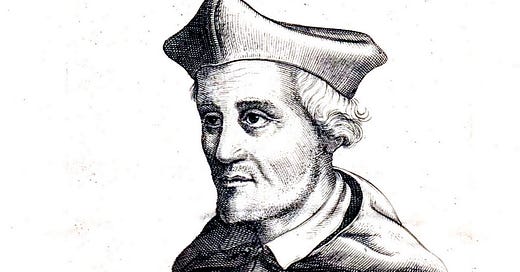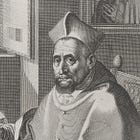How to defeat a destroyer pope
Cajetan's exhortation is very applicable to defeating a usurper 'pope' too.

Cajetan's exhortation is very applicable to defeating a usurper 'pope' too.
Editor’s Notes
The following text is by the scholastic theologian Cardinal Thomas de Vio Cajetan OP (1469–1534).
Cajetan was a renowned commentator on St Thomas Aquinas and one of the most influential theologians of his time.
In his brief discussion on the possibility of a pope attempting to destroy the Church, Bellarmine refers readers to two specific treatments—one from Cardinal Torquemada and the other from Cardinal Cajetan.
Bellarmine’s “resistance quotes” (there are two) are ubiquitous in traditionalist discourse today. But many presume that it is relevant to our current situation.
These texts from Bellarmine—as well as those from Cajetan and Torquemada—have been presented to justify…
The possibility of a pope trying to destroy the Church through the profession and teaching of heresy and promulgation of evil laws, namely within the legitimate sphere of his authority
The continuing legitimacy of such a pope
The necessity of resisting this pope within this legitimate sphere of his authority.
However, this is not borne out in the particular texts from Torquemada and Cajetan, let alone in the immediate context of Bellarmine’s work.
As proof of this, we are considering those texts, to which Bellarmine points. Both explicitly exclude consideration of a pope spreading heresy, and instead focus on issues such as simony, nepotism and profligacy.
The present text from Cajetan
We have already provided the text from Torquemada.
The full text from Cajetan is forthcoming, although we have separated this mini-treatise on prayer from the rest of the text.
The section from Cajetan is Chapter 27 of his treatise On the Authority of Pope and Council. What follows is an extended passage from this chapter, in which Cajetan emphasises prayer as the primary means of defeating a wicked pope, or one who is destroying the Church.
Such a pope, Cajetan explains, is defeated by being converted, being removed, or being suffered in accordance with the will of God.
This is because the most perfect defeat of a “destroyer pope”—or of a usurper—is his conversion to the faith, and his salvation.
Our duty to pray for this recalls St Paul’s words to the Romans:
Be not overcome by evil: but overcome evil by good. (Romans 12.21)
Evil popes vs heretic popes
It is essential to remember that Chapter 27 explicitly concerns:
Popes who are attempting to destroy the Church through means other than teaching heresy, or
Popes who are evil, scandalous or tyrannical.
Cajetan explicitly excludes papal claimants who fall into heresy or attempt to teach heresy. All through this section he refers to a pope who retains the faith. It is also evident throughout Chapter 27 (to be provided in due course) and in the objections raised in Chapter 24, to which Chapter 27 responds.
By contrast, he gives the following examples of ways in which a pope may attempt to destroy the Church:
Tyrannical rule – Acting violently against the Church.
Simony – Selling ecclesiastical offices and benefices.
Squandering Church resources – Using the wealth of the Church for personal or familial gain, even demolishing sacred buildings for private projects.
Dismantling the hierarchical order – Deposing all bishops or undertaking other acts that would cause disorder in the Church.
General corruption and scandal – Acting in a morally reprehensible or scandalous way.
Ignoring correction – Refusing to amend his actions despite all human efforts.
Exceeding his authority – Acting as though the Church exists for him rather than he for the Church.
Spreading heresy, promulgating evil laws to the universal Church, and imposing a false religion are conspicuously absent from this chapter—as they are from Torquemada’s chapter on the same subject, and the chapter in which Bellarmine’s “resistance quotes” are found.
As such, these chapters cannot be used to argue that popes can do this, and must be resisted when they do so. Such ideas are simply outside the scope of these chapters, and are contradicted by weighty arguments elsewhere.
This means, in turn, that Cajetan’s remarks on prayer, resignation, and divine providence were not applied to a heretic “pope,” who destroys the Church through heresy. He deals with the question of a heretical pope is addressed in an entirely different chapter.
All this shows that it would be a mistake to think that Cajetan would have us quietly pray, and do nothing else, in our current situation. This is to say nothing of the fact that the so-called “fourth opinion” which he endorsed at one time (later apparently adopting some form of the “second opinion”)—necessarily entails taking positive action to remove a heretical pope from office.
(How many advocates of the “fourth opinion” are taking such positive action today?)
Nonetheless, Cajetan’s insights on prayer remain startlingly relevant, in themselves and even to our own situation.
In this piece, he shows us:
How divine wisdom provides a higher remedy for a pope who retains the faith but governs in an incorrigibly harmful way.
That men expect the fruits of prayer without truly praying, and then complain when they don’t receive these fruits.
How naturalism and a misplaced trust in human prudence leads to complaint against God, when he fails to convert or remove the destroyer pope.
Cajetan also shows us that trust in divine providence is not an excuse for inaction but a call to confidence in the power of prayer. If God permits a corrupt pope who has retained the faith to afflict the Church, it is not because he has abandoned her, but because he calls her to seek his intervention, trusting that he will never allow her to be overcome.
Relevance to our situation
Cajetan’s counsel on prayer, resignation, and trust in divine providence conveys timeless and universal principles.
There are two key points of comparison between his treatment of true popes destroying the Church and our situation, in which false claimants are destroying the Church.
Our situation differs in kind, yet Cajetan’s principles still apply.
Today, the illegitimate usurpers of the Holy See remain physically in the Vatican, with their collaborators entrenched in dioceses across the world. The crisis exists precisely because these usurpers do not hold their offices, and yet have not been removed.
Cajetan speaks of a true pope—one whose conversion, removal, or endurance is achieved through prayer and left to divine providence.
We speak of a false pope—yet for us, clergy and faithful, the response includes (but is not limited to) similar means.
This brings us to the second comparison.
God permits both destroyer popes and usurpers as chastisements.
Even though these false popes have already lost office and possess no authority, we must accept that God chastises us through them.
This does not mean pretending such a man is pope.
On the contrary, we must embrace reality and truth—not wishful thinking, nor a cowardice presented as “prudence.”
Both a “destroyer pope” and a usurper are “defeated” by being converted, being removed, or being suffered in accordance with the will of God.
And, for the same reasons given by Cajetan for his scenario, such a defeat is not won without prayer.
We will provide the remainder of Cajetan’s chapter in due course.
See also:




